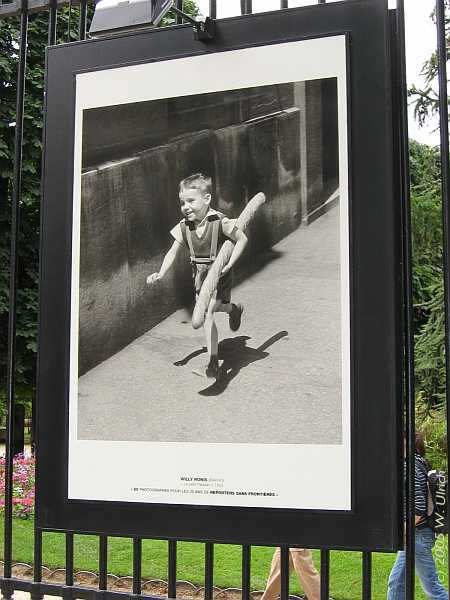Werner Ulrich's Home Page: Picture of the Month
Now "Ulrich's Bimonthly"
October 2005

Paris for beginners (Part 2 of 2) I said in Part 1 that I wanted to offer a few footnotes on Paris for beginners. The term "footnotes" was meant to convey a certain modesty of my undertaking, but it occurred to me that you may take it literally: my notes are footnotes because we mainly discovered Paris on foot. In fact, when I think of the city's many street cafés and parks, its surprisingly numerous bookshops and bakeries, and the plenty of other charming places it offers you for sitting down and just being (such as the chairs ready for anyone in the Jardin du Luxembourg), I suspect Paris is the world's most attractive metropolis for pedestrians. Paris est belle, especially on foot. Enjoy the second part of my footnotes – see you in Paris!
|
|
For a hyperlinked overview of all issues
of "Ulrich's Bimonthly" and the previous "Picture of the
Month" series,
see the site map

Louvre - Probably
the most famous museum of the world, I liked the Musée du Louvre
both for its architecture and for its art exhibitions. The
inner squares of the Louvre, particularly the large Cour Napoléon
with the Glass Pyramid created by the Chinese-American
architect Ieoh Ming Pei (inaugurated in 1989), are definitely worthwhile seeing, even if you do not
plan to enter the museum. 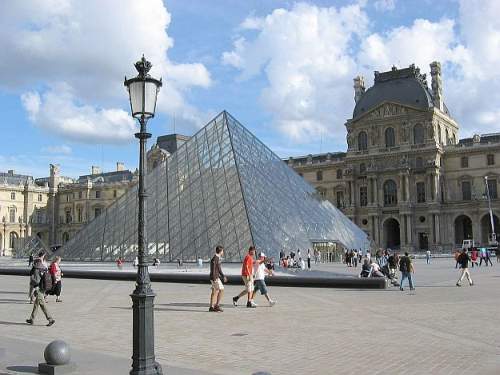 Brilliant combination of Renaissance and
modern architecture – a stroke of genius! After a day of extended
walking
in the city, how refreshing it is just to sit there quietly in face
of the Pyramid, enjoying the relaxed ambience of the place in the evening sun!
Brilliant combination of Renaissance and
modern architecture – a stroke of genius! After a day of extended
walking
in the city, how refreshing it is just to sit there quietly in face
of the Pyramid, enjoying the relaxed ambience of the place in the evening sun!
The
star of the Museum, of course, is the ![]() Mona
Lisa. Seeing her chop-chop does not take much more than, say,
an hour, but better plan a full day to get a valid first impression of
the Museum. Its permanent collections, divided into eight departments,
comprise no less than 35,000 works of art displayed in some 60,000
square meters of exhibition space. Personally I regretted that the cut-off point
for the permanent collections is 1848; more recent art is shown
only in changing temporary exhibitions. .
Mona
Lisa. Seeing her chop-chop does not take much more than, say,
an hour, but better plan a full day to get a valid first impression of
the Museum. Its permanent collections, divided into eight departments,
comprise no less than 35,000 works of art displayed in some 60,000
square meters of exhibition space. Personally I regretted that the cut-off point
for the permanent collections is 1848; more recent art is shown
only in changing temporary exhibitions. .
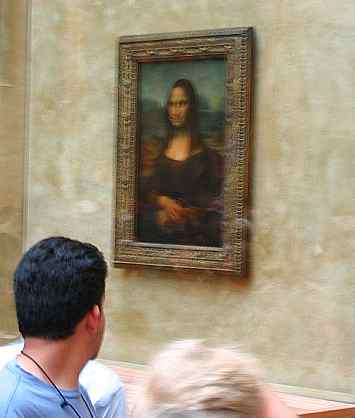 Mona
Lisa - It was kind of a battle
to get half-way close to Leonardo da Vinci's famous painting, "La Jaconde" (la Giocanda), popularly known as the Mona Lisa (short
form for "Madonna Lisa") and painted in the years 1503-06
or so. Probably the lady's true name was Lisa
Gherardini, wife of Francesco del Giocondo, a Florentine silk
merchant; but her identity is controversial. If the painting does
indeed show La Gioconda, she would have been around 25 years of age
when da Vinci painted her portrait.
Mona
Lisa - It was kind of a battle
to get half-way close to Leonardo da Vinci's famous painting, "La Jaconde" (la Giocanda), popularly known as the Mona Lisa (short
form for "Madonna Lisa") and painted in the years 1503-06
or so. Probably the lady's true name was Lisa
Gherardini, wife of Francesco del Giocondo, a Florentine silk
merchant; but her identity is controversial. If the painting does
indeed show La Gioconda, she would have been around 25 years of age
when da Vinci painted her portrait.
The
Museum apparently decided to let the crowds sort it out themselves
who should have the right to get close to the painting and how long
anyone should be allowed to occupy the precious space in front of
it, according to the motto: survival of the fittest. Amazingly
unorganized and chaotic – not exactly an opportunity for contemplating
the beauty of the painting. On the positive side, the painting really
is very special. It's worth battling for your right to see it! If
you make it through the battle, you are rewarded not only by Lisa's
enigmatic smile, but are even allowed to take photographs of her!
What a pleasant difference to the majority of Museums where taking
pictures is strictly forbidden. There are some plans to restrict
photography in the Louvre, too, but I would suggest what should
be restricted is not the right of taking pictures as such but only
the use of flashlights.
Centre
Pompidou - Inaugurated in 1977,
this must be the most
extrovert building of the world, although
hardly the most beautiful one – some
locals affectionately call it the "oil refinery." In any
case, the
idea of moving escalators, water pipes and air conditioning
to the outside of the building, so as to save interior space for more productive
use, is certainly original and makes for an interesting building,
both inside and outside. In addition to a huge and popular public
library that occupies three floors, as well as a bookshop, a movie theater and a panoramic terrace,
the building hosts in floors 4 and 5 an excellent exhibition of
contemporary art, the Musée National d'Art Moderne
(MNAM),
with some 45,000 works of artists such as Kandinsky, Matisse, Miró, Picasso,
and many others. After the ![]() Louvre,
I needed that!
Louvre,
I needed that!
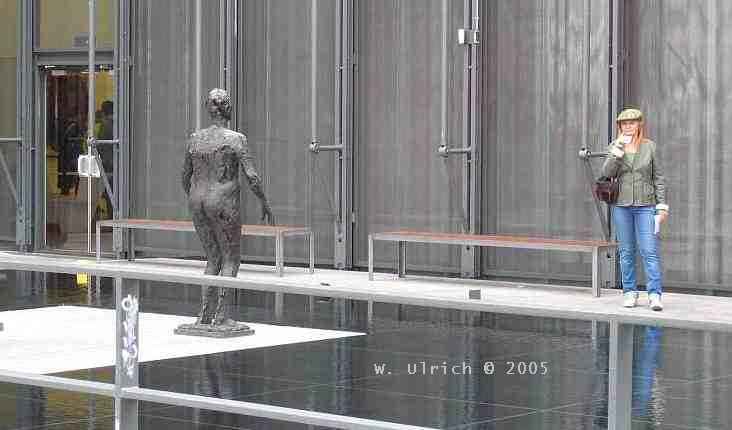
Besides,
the Pompidou Center offers an excellent view of the roofs of
Paris, with the Eiffel tower and the ![]() Montmartre
in the background (see the picture under "Montmartre").
I also liked the ambiance of the square in front of the building, the Place Georges Pompidou, with its
oversized ventilators and other installations belonging to the building,
its street artists, and the neighboring Igor Stravinsky Square with
the lively and original
Montmartre
in the background (see the picture under "Montmartre").
I also liked the ambiance of the square in front of the building, the Place Georges Pompidou, with its
oversized ventilators and other installations belonging to the building,
its street artists, and the neighboring Igor Stravinsky Square with
the lively and original ![]() Stravinsky
fountain.
Stravinsky
fountain.
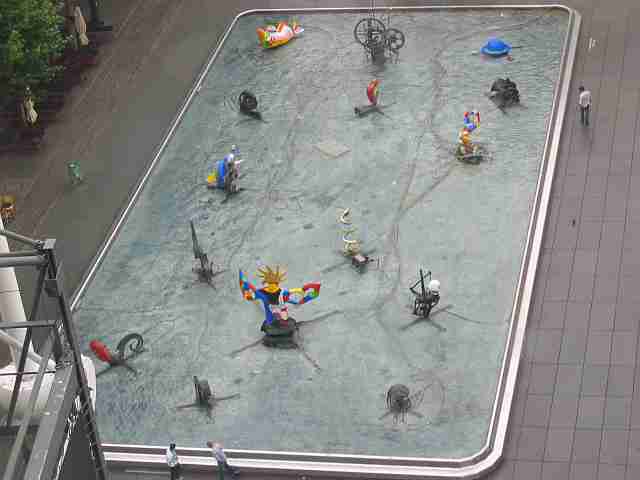
Stravinski
fountain - The first modern
fountain of Paris. Situated on the
Place Stravinsky in front of the ![]() Centre Pompidou, this is
a charming work of art created in 1982/83 by Niki de
Saint-Phalle (1930-2002) and Jean Tinguely (1925-1991) in homage
to Stravinsky's ballet "Le Sacre du Printemps." It features
16 mobile gargoyle figures in the unmistakable, nicely contrasting
styles of the two artists.
Centre Pompidou, this is
a charming work of art created in 1982/83 by Niki de
Saint-Phalle (1930-2002) and Jean Tinguely (1925-1991) in homage
to Stravinsky's ballet "Le Sacre du Printemps." It features
16 mobile gargoyle figures in the unmistakable, nicely contrasting
styles of the two artists.
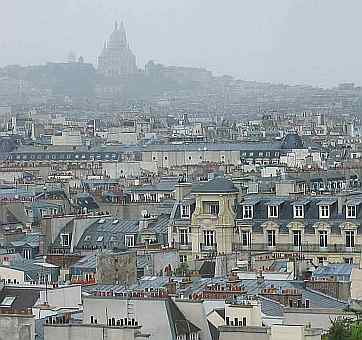 Montmartre - It's
a long and steep way up the stairs to the Montmartre neighborhood
and to the Basilique du Sacré Coeur. Opinions differ about
the artistic value of the Basilique, but its situation on
top of the city and the near-by colorful Place du Tertre,
where a few dozens would-be artists try to get the tourists to part
with their money, are certainly worth discovering. The picture here
was taken on a rainy day from the
Montmartre - It's
a long and steep way up the stairs to the Montmartre neighborhood
and to the Basilique du Sacré Coeur. Opinions differ about
the artistic value of the Basilique, but its situation on
top of the city and the near-by colorful Place du Tertre,
where a few dozens would-be artists try to get the tourists to part
with their money, are certainly worth discovering. The picture here
was taken on a rainy day from the ![]() Centre
Pompidou.
Centre
Pompidou.
Jardin
du Luxembourg - In which other
city can you go to a park and expect to find dozens (if not hundreds)
of free chairs to sit down and relax, read a book, have a picnic,
paint, or whatever? Here you can! After an extended walk through
Saint-Germain-de-Prés and the Quartier Latin, my wife and I
passed a leisurely hour sitting close to the water. "A day spent loitering here teaches you more about Paris and its inhabitants than
many a scholarly tome," David Downie writes in Paris, Paris, Journey into the City
of Light (Stuttgart, Germany: Transatlantic Press, 2005, Ch. 1).
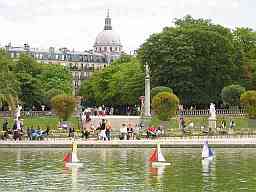
Picnic - Heavily
en vogue throughout the city, whether along the Seine River
or in one of the many parks, street places, bridges.... ![]() Jardin
du Luxembourg,
Jardin
du Luxembourg, ![]() Boulangéries.
Boulangéries.
Boulangéries - An
indispensable element of the vie parisienne. They sell not only
the mandatory croissants but also the equally unavoidable
baguettes. There is no better way to illustrate the significance
of getting your fresh baguette every morning and evening than by
the beautiful photograph "Le petit Parisien," which Will
Ronnis shot in 1952 and which is currently exposed as a poster close
to the eastern entry of the Luxemburg Gardens. I love this
picture. Its deeper mystery for me is that le petit Parisien
strikingly resembles the little boy I was some 50+ years ago (roll
your mouse over the picture to see that other little boy).
|
October 2005 |
|---|
Su Mo Tu We Th Fr Sa 1 2 3 4 5 6 7 8 9 10 11 12 13 14 15 16 17 18 19 20 21 22 23 24 25 26 27 28 29 30 31 |
October, 2005
«Le
petit Parisien» (roll
over)
Poster
by Will Ronnis,1952, at the eastern entry of the Jardin du Luxembourg
"Cette ville est un autre monde.
Dedans, un monde florissant,
En peuples et en biens puissants
Que de toutes choses abonde."
(This city is another world / Therein a flowerful world / Of people very powerful / To whom all things abound)
Inscription
in the Plan de Merian (1616),
a medieval map of Paris by Matheus Merian Basiliensis
Notepad for capturing personal thoughts »
|
Personal notes:
Write
down your thoughts before
you forget them! |
|
Last
updated 6 Dec 2009 (layout) and 15 July 2007 (roll-over picture added; first published 2 Oct 2005)
https://wulrich.com/picture_october2005.html
